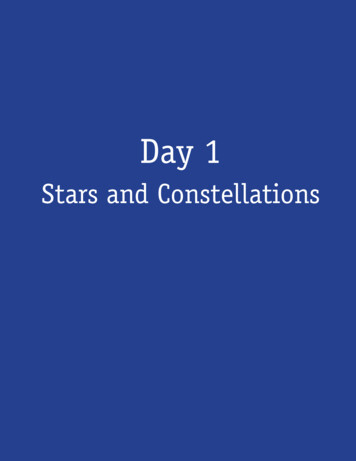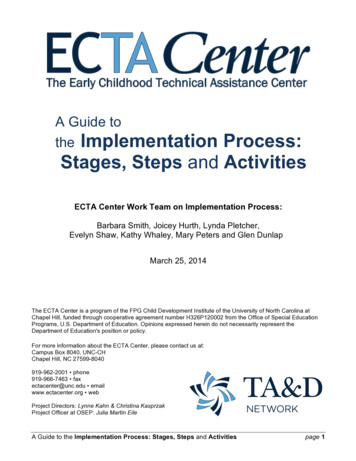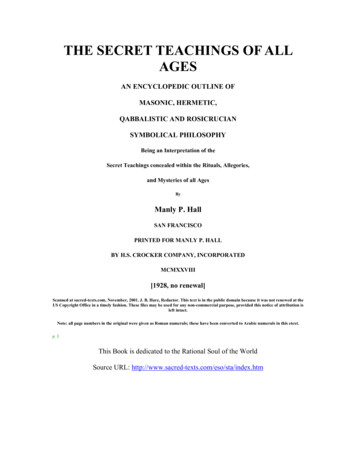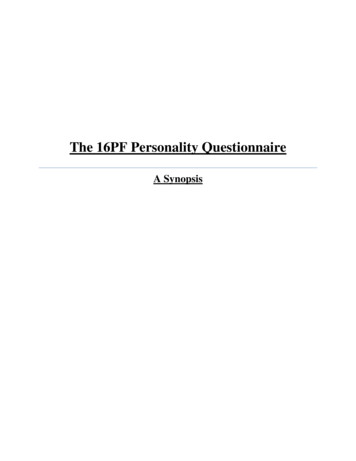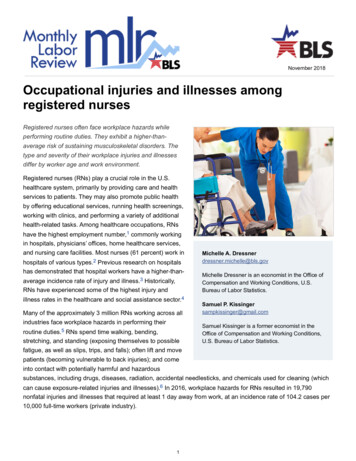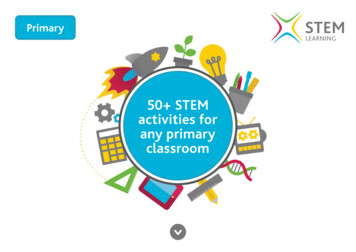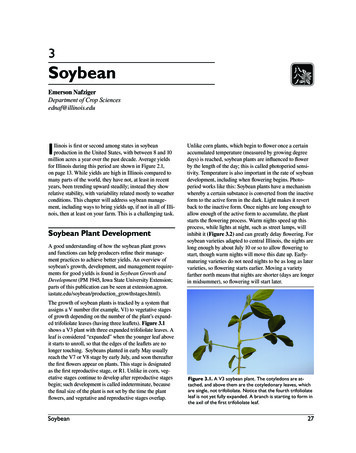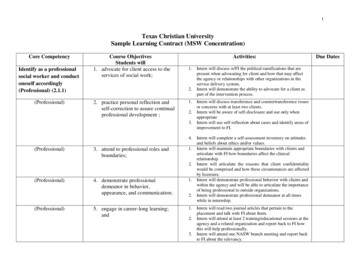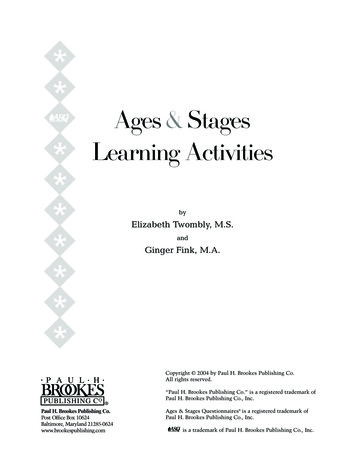
Transcription
** *******Ages & StagesLearning ActivitiesbyElizabeth Twombly, M.S.andGinger Fink, M.A.Copyright 2004 by Paul H. Brookes Publishing Co.All rights reserved.“Paul H. Brookes Publishing Co.” is a registered trademark ofPaul H. Brookes Publishing Co., Inc.Paul H. Brookes Publishing Co.Post Office Box 10624Baltimore, Maryland 21285-0624www.brookespublishing.comAges & Stages Questionnaires is a registered trademark ofPaul H. Brookes Publishing Co., Inc.is a trademark of Paul H. Brookes Publishing Co., Inc.
**About the Authors*Elizabeth Twombly, M.S., lives in Eugene, Oregon, and is Senior Research Assistantof the Early Intervention Program at the University of Oregon, Eugene. Prior toworking in the field of early intervention, Elizabeth spent many years working withyoung children in environmental education, child care, and preschool programs onthe east and west coasts. Elizabeth has been involved in the Ages & StagesQuestionnaires (ASQ) project since the early 1990s and was involved in the initialdevelopment and research for the Ages & Stages Questionnaires : Social-Emotional(ASQ:SE). She trains across the nation on the implementation of these screeningtools in a variety of health and educational programs that work with families withvery young children. Elizabeth is coordinating projects in the Early InterventionProgram that relate to screening systems and infant mental health.Ginger Fink, M.A., has worked in the field of early childhood education for morethan 30 years. She has worked in many capacities as a teacher, director, curriculumdeveloper, and teacher educator. She is a private consultant in the area ofparent–child programs and teacher education strategies.She worked as curriculum developer from 1987 to 1996 for the KamehamehaSchools, Honolulu, Hawai’i, toward development of a statewide series of community-based parent–child programs. She also worked extensively with Head Start programs as teacher and program director intermittently between 1966 and 1975, andas disabilities specialist between 1997 and 2000 for the Region X training and technical assistance network. She also served as the training coordinator for the Ages &Stages developmental screening system for the University of Oregon, Eugene. Inaddition to private consultation, she teaches early childhood courses at ClackamasCommunity College, Oregon City, Oregon.
**Introduction*Welcome to the Ages & Stages Learning Activities. These activities have beendesigned to coordinate with Ages & Stages Questionnaires (ASQ): A ParentCompleted, Child-Monitoring System, Second Edition (Bricker & Squires, 1999).These simple activities were designed to provide parents, home visitors, teachers,and others with quick, inexpensive ideas for learning games and interactions thatenhance the growth and development of infants and young children. These activities are written in simple language and use materials that most families have onhand at home.In addition to supporting areas of development, it is the authors’ hope that theseactivities strengthen the parent–child relationship. To this end, the activities aredesigned to be playful, fun, and affectionate. The authors hope that these activitieswill bring laughter and joy to the family. Although the Ages & Stages LearningActivities are designed for use with the ASQ system, they are appropriate to useindependent of a screening or monitoring program.THE ASQ AND AGES & STAGES LEARNING ACTIVITIESThe ASQ is a series of parent-completed questionnaires that screen and monitor achild’s development between 4 months and 5 years of age. The results of a questionnaire determine if a child is currently developing at an age-appropriate level orif he or she should receive a more in-depth assessment from a local early intervention/ early childhood special education agency to determine the need for specializedservices. The ASQ screens development in the areas of communication, gross motor,fine motor, problem solving, and personal-social skills.Because a parent or caregiver, not a professional, completes the ASQ, the ASQprovides an inexpensive method for screening and monitoring a child’s development. Screening with the ASQ elicits three potential results: Well above the ASQ cutoffs: The child appears to be developing typically at thispoint in time. Below the ASQ cutoffs: The child falls on or below a statistically derived cutoff andshould be referred to a professional to determine if he or she is eligible for specialized services. Close to the ASQ cutoffs: The child falls close to a cutoff; the score is questionableand the child appears to need some additional support in one or more developmental areas. At this time, however, the child is not showing a delay that is significantenough to warrant a referral.The Ages & Stages Learning Activities are designed to be used to follow up withchildren who receive a result of well above the ASQ cutoffs or close to the ASQ cutoffs when screened using the ASQ. If a child scores below the cutoffs and is referredand determined not eligible for specialized services, the learning activities also canbe used. However, these activities are not intended to be a comprehensive intervention that meets the needs of a child with an identified developmental delay. As mentioned previously, these children should be receiving in-depth individualizedinstruction from an early intervention or early childhood special education provider.
If appropriate, the activities could be used to support an intervention program.The Ages & Stages Learning Activities are organized to coordinate with the ASQand are grouped according to 1) age of the child and 2) area of development. Whilethe ASQ system includes 19 questionnaires, Ages & Stages Learning Activities contains 12 sets. Table 1 provides guidelines as to which age range of the LearningActivities should be provided following screening with the ASQ.AGES & STAGES LEARNING ACTIVITIES SHEETSThere are five activity sheets in each set of the Learning Activities: communication,gross motor, fine motor, problem solving, and personal-social. Although it is recognized that every activity a child engages in can provide opportunities to practice andenhance multiple skills, these activities focus on one specific area at a time so thatcaregivers concentrate their attention on each specific area. In addition, the pronouns he and she alternate throughout the series of activities, but the activities areintended to be appropriate for either boys or girls.Following a screening, program staff members have the option of providing a fullset of Ages & Stages Learning Activities to a caregiver or selecting specific areasdepending on screening results. For example, a child at 12 months may receive aresult of well above the ASQ cutoffs in the areas of communication, gross motor,problem solving, and personal-social but a result of close to the ASQ cutoff in the fineTable 1. ASQ and Ages & Stages Learning Activitiesage-range guidelinesAfter screeningwith the ASQquestionnaire forProvide the followingset of Ages & StagesLearning Activities for1–4 months4 months4–8 months6 months4–8 months8 months8–12 months10 months8–12 months12 months12–16 months14 months12–16 months16 months16–20 months18 months16–20 months20 months20–24 months22 months20–24 months24 months24–30 months27 months24–30 months30 months30–36 months33 months30–36 months36 months36–42 months42 months42–48 months48 months48–54 months54 months54–60 months60 months
motor area. In this case, staff can choose to provide caregivers with a full set of 12to 16-month activities or with only the 12- to 16-month fine motor activities.Each activity sheet includes a brief description of what might be typical in termsof development at that specific age span. Because development is different for eachchild, a child’s skills may or may not be reflected in this description. It is importantfor caregivers to be responsive to the unique developmental needs and strengths ofeach child.After the brief developmental description, a series of between five and eight ageappropriate activities are provided. The activities provide opportunities to develop avariety of skills in each developmental area and to practice skills that are targetedon the ASQ screening; however, these activities should not be considered all inclusive. Children learn from adults in hundreds of ways, and these are just a few. Somemay be new; many others are time tested and familiar. We hope that parents will addto these activities from their own experiences. Home visitors and other helping professionals are invited to add to these suggestions or to modify activities to meet aspecific child’s or family’s needs.In each set of activities, the authors have included games or activities that support language and literacy development. We hope that some of the foundations of literacy will be encouraged in every child’s home, such as experimenting with rhythmand rhymes; gesturing; speaking; listening; reading books, magazines, newspapers,and signs on the street and in stores; experimenting with writing tools by scribbling,drawing, creating grocery lists, and writing letters and cards to loved ones; and soforth. The love and enjoyment of reading as well as success in later formal school situations can be rooted in these early childhood years.Adaptations may be necessary to respectfully support families whose first language is not English or who come from diverse cultural backgrounds. Althoughthese activities are written in English, the authors hope that home visitors or parentswill feel free to adapt them to their home language and to add games from their tradition or experience. All cultures have special favorite baby games, rhymes, andsongs. When a baby hears these loving sounds, his or her knowledge of who he orshe is will be strengthened. In some cases, a learning activity may not be somethinga family might choose to teach. For example, some families may not wish to engagetheir children with mirrors. Respect for the family’s values must guide the interactions and choices.Activities are written at a fourth- through fifth-grade reading level. Although thisreading level may meet the needs of many families, other families may need additional support. Activities may need to be demonstrated, illustrated, or shared verbally with families. For example, a home visitor can introduce a new activity to afamily each week, bringing specific toys or helping family members gather materials in their home environment. Of course, it is important to consider safety guidelinesfor children at each developmental level. Although some of the activities includesafety precautions, an adult should supervise all activities that involve young children. Use the activities with flexibility.REFERENCEBricker, D., & Squires, J. (with Potter, L., Nickel, R., & Farrell, J.). (1999). Ages &Stages Questionnaires : A Parent-Completed, Child-Monitoring System (2nd ed.).Baltimore: Paul H. Brookes Publishing Co.
****CommunicationActivities to Help Your Baby Grow and LearnYour wonderful new person communicates with her whole body. Her gazeat you tells you that you are the most important person in the world. Shecommunicates with body movements, noises, and her own special cry when she needs something. Yourbaby’s favorite music is your gentle voice. Even though she enjoys the sounds of a busy household,some quiet time is important so baby can hear family voices.Song and Rhyme Introduce your baby to the chant, rhyme, and rhythm of your favorite songsand nursery rhymes. Change the words of a familiar tune. Add baby’s namenow and then (“Twinkle, twinkle, little Andy. How I love my little Andy”).Sing and Talk as As you bathe, feed, exercise, or change your baby, sing any song. Make up yourYou Take Care own songs. Let your baby watch your face while you talk and sing. Encourageother family members to do this. Baby knows how important she is.Funny Baby During quiet, happy times encourage your baby to smile. Make funny (notscary) faces that baby likes. When baby smiles, be sure to make that faceagain. Tell baby how funny he is!Picture Books With baby cuddled on your lap, hold a book with simple, clear, colorful pictures so that both of you can see. Talk softly about what you see as you pointto the pictures. Baby will learn that reading time is very special.Special When your baby is awake, cuddle her and hold her so she can see your face.Talking Time Talk for a little while. Look at her face as she looks at yours. Encourage herto make different sounds, coos, and squeals. Have a conversation.Words for As you comfort baby when he cries, talk about why he is crying. Try to figBaby’s Cry ure out what’s wrong, and tell him about it as you take care of his needs.Noticing Sounds When sounds happen around the house, help baby notice by talking aboutthem (“I hear the telephone ringing,” “I hear your brother calling”).Telephone Time When you are on the phone, hold your baby close and look at her. Baby willenjoy watching and listening to you. She’ll think your conversation is just forher!***Ages&Stages1–4 monthsAges & Stages Learning Activities by Elizabeth Twombly and Ginger Fink. Copyright 2004 by Paul H. Brookes Publishing Co. All rights reserved.
****Gross MotorActivities to Help Your Baby Grow and LearnBaby is gaining strength right from the beginning. He practices lifting andcontrolling his head. He moves his arms and legs. Soon he will be able to roll to his side from his back.He likes being held so that his feet gently touch a surface. He likes to be held in a sitting position so thathe can strengthen his back and tummy muscles and see what’s going on.Position Changes When baby is awake, place baby in a different position, on her stomach orside. This will allow baby to move her arms and legs in different ways ordirections. Always watch baby when she’s on her stomach.Kicking Practice Place baby on his back on a firm surface. As you talk quietly to baby, encourage him to move his legs. Hold a foot in each hand and gently move themback and forth.Heads Up Put baby on her stomach. Dangle a bright toy in front of her, or make facesand sounds to encourage your baby to lift her head.Bath Time One special way to bathe baby is in the tub with you. Enjoy gently massaging his legs, arms, tummy, and back. Allow baby to kick and splash as youhold him safely and talk and sing a little bathtub song.Balancing Act Stand baby on your knees and gently hold her in a standing position. Let her(about 3–4 months) support as much of her own weight as she can to help her strengthen her legsand gain balance.Roll Over Encourage baby to roll from his stomach to his back by holding a bright toyin front of him and slowly moving it over to the side. You may help him rollover until he can do it himself.Pretty Pull-Ups With baby on your lap, pull baby up slowly by her arms. Then, gently lower(about 3–4 months) her in an up-and-down game. Talk to her as she moves up and down. Thiswill help to strengthen stomach muscles and let baby see the world and yoursmiling face from a different point of view.***Ages&Stages1–4 monthsAges & Stages Learning Activities by Elizabeth Twombly and Ginger Fink. Copyright 2004 by Paul H. Brookes Publishing Co. All rights reserved.
****Fine MotorActivities to Help Your Baby Grow and LearnYour baby is gaining control of her gaze and can focus on a nearby object for afew seconds. Soon she’ll be able to follow you with her eyes while you movearound. Her fist will grasp your finger and hold on tightly. She will show excitement by waving her arms. It is a wonderful time of beginning to notice what’s going on in the world!Finger Kiss When feeding baby, encourage him to touch your lips (if he doesn’t do thisspontaneously). Kiss his fingertips. Baby will learn the soft, wet sensation ofyour lips and soon will learn to aim his fingers toward your lips.Gotcha While your baby is lying on a rug or sitting in her infant seat, offer a toy or(about 3–4 months) something to grasp just beyond her reach. When she reaches for it, makesure she gets it. She’ll probably taste it, too.Finger Grip Let your baby grab your finger and grip it tightly. Gently tug a little just to letyour baby know you’re there. “My, you are so strong!”Finger and Toe Rub Rub your baby’s fingers and toes one at a time. A little baby lotion makes thisespecially nice. Your baby will enjoy the sensation. It will increase his bodyawareness.Ribbon Flutter Hang a long, brightly colored ribbon or scarf loosely around your neck.When you lean over to change baby or pick her up, let her reach out andtouch the ribbon. Sit and talk about what she is doing.Tug-O-War Let baby grasp a dishcloth or the corner of a washcloth. Gently tug the otherend. Tell him how strong he is. Let go, and let him win!***Ages&Stages1–4 monthsAges & Stages Learning Activities by Elizabeth Twombly and Ginger Fink. Copyright 2004 by Paul H. Brookes Publishing Co. All rights reserved.
****Problem SolvingActivities to Help Your Baby Grow and LearnYour baby already responds to sounds and voices. He’s beginning to look for thesource of the noise. He also looks at his surroundings and will show an activeinterest in a person or toy. He likes to study things like his own hands and his favorite face—yours!Tracking Fun Let baby follow a rattle, a shiny spoon, or your face with his eyes. Hold yourface or an object 10–12 inches from baby’s face and slowly move from left toright. Talk softly as you play. Baby will enjoy being part of the action.Light Touch Stroke your baby gently with a feather, a cotton ball, or the edge of a cloth.Your baby will enjoy the sensation as she learns to isolate different bodyparts. Talk to baby softly. Describe what she is feeling.Cotton Ball Sniff To help your baby develop his sense of smell, dip cotton balls in different fragrances such as mint or vanilla extract. Gently waft these near baby so he canexperience the scent. “Mmm, it smells so good.”Making Faces With baby on her back, lean over her and make surprised or happy faces.Encourage her to reach for your nose or lips or mouth. Have a little laughtogether.Colorful Socks Put a brightly colored sock on your baby’s foot. This will encourage her tolook at her feet, then pull at them and catch a foot. This game will help babydiscover parts of her own body.Silver Spoons Lie your baby on his back, and dangle a shiny spoon above him so he canreach and bat it. A shiny spoon also makes a nice hanging crib toy to entertain baby as long as it is safely tied out of reach.Reaching Practice With your baby in your lap or the lap of another special person, hold up a(about 3–4 months) safe, interesting toy on a string for him to reach for. Let baby be successfulby slowly moving the toy to his fingers.***Ages&Stages1–4 monthsAges & Stages Learning Activities by Elizabeth Twombly and Ginger Fink. Copyright 2004 by Paul H. Brookes Publishing Co. All rights reserved.
**** Personal-SocialActivities to Help Your Baby Grow and LearnBaby will look into your eyes to tell you “I’m yours.” She lovesand needs a lot of holding and physical contact. When she needsyou, she will fuss or cry. Your response and gentle voice will comfort her. When she is taking in information, she will be calmer. This is often after eating, resting, or having a diaper changed. At about 7weeks old, she will respond with a beautiful smile!Love and Respond right away when baby cries. It’s her way of telling you somethingTrust Building important. Carry, hug, smile, sing, and talk to baby often. It’s your way of saying, “I love you and I’ll take care of you.”Communicating After his bath, baby may be ready for a massage. Use baby oil and gentlyThrough Touch massage his arms, hands, legs, feet, back, tummy, and bottom. Continue onlyas long as your baby is quiet and content. Talk or sing a little song. You canmake it up—baby won’t mind.Funny Face Play Make an “oh” face; stick out your tongue or pucker your lips when babyseems to be studying your face. Hold that expression and see if your baby willimitate it. Smile if baby copies you!Looking in Hold your baby up in front of a mirror. She may enjoy smiling and makingthe Mirror noises at herself. As baby looks in the mirror she is learning about your gentle touch and about the “other” baby she sees.Peekaboo Play Peekaboo with your baby. Place your hands over your eyes then overbaby’s eyes. Release your hands and say, “Boo.” Place a blanket over yourhead and come out saying, “Boo.” Your baby will enjoy many variations ofthis game for a long time to come.Happy Hands As baby’s fist begins to relax, place a small toy in his hand. He won’t be verygood at letting go just yet. Let him grasp your finger while you nurse. Later,guide his hands to hold his bottle. Smile and tell him how strong he is!***Ages&Stages1–4 monthsAges & Stages Learning Activities by Elizabeth Twombly and Ginger Fink. Copyright 2004 by Paul H. Brookes Publishing Co. All rights reserved.
****CommunicationActivities to Help Your Baby Grow and LearnYour baby has learned to use his voice: He squeals and is beginning to babble to you and to others. He knows his name and may use his voice to letyou know he is happy. He can shout for your attention and is about to make sounds such as “mama”or “dada.” He is also learning to respond to “bye-bye.”Baby Rubdown After bath time, enjoy some quiet time talking with your baby as you gentlyrub him down with lotion or oil. Tell him about your day—ask about his.What’s That? When your baby notices a sound, help her locate the source. Ask your baby,“What’s that? Daddy’s car?” “Did you hear a dog?”Touch that Sound As your baby begins to experiment with his voice, you will probably hear(about 5 months) /b/, /m/, and /d/ and “ah,” “ee,” and “oo” sounds. Imitate the sounds babymakes. While you make the sound, let your baby put his fingers on your lipsto feel the vibrations.Trust Building When you move away from your baby to do other things, keep in touch withwith Words your baby through your words. Tell her what you are doing as she followswith her eyes. “I’m over here. I’m picking up the clothes. I’ll be right back.”Now and then step out of sight, but continue to talk until you return. “Did youmiss me?”Reading Time Your baby will enjoy looking at pictures in magazines or books. Choosethings such as a telephone, dog, car, or spoon. Sit with your baby on your lapand read about the pictures. Tell a little story. “See the phone? It’s for you.”Sing a Song When you are bathing, diapering, or changing your baby’s clothes, sing asong such as “This is the way we wash our toes, wash our toes, wash our toes.This is the way we wash our toes, so early in the morning.”Hide-and-Seek Move just out of sight and call baby’s name. Wait a few seconds, and thenreappear. “Here I am!” Now find another place and hide again.***Ages&Stages4–8 monthsAges & Stages Learning Activities by Elizabeth Twombly and Ginger Fink. Copyright 2004 by Paul H. Brookes Publishing Co. All rights reserved.
****Gross MotorActivities to Help Your Baby Grow and LearnYour baby gets stronger every minute. She now holds her head up andlooks all around at everything that’s going on. She is learning to sit by herself, even though at first sheuses her hands for support. She loves bearing her weight on her legs and will soon pull to stand.Floor Time Spread out a quilt on the floor or outside under a tree. Put your baby on theblanket on her tummy with a few of her favorite toys and encourage her tostretch, scoot, roll, squirm, or wiggle her way to the toys. Be sure to give sometime for baby to be on her back, too.Sitting Pretty Help your baby sit alone. Sit behind him and give him some gentle support.He can hold a toy or a book. Whisper in his ear that he is a wonderful baby!As he learns to sit by himself, you can give him less help.Bouncy Baby Hold on to your baby’s hands and help her stand up. Have fun bouncing upand down while she’s standing on the floor, the sofa, or your lap. Sing a little bouncing chant: “Bouncy, bouncy, bouncy, stop. Isn’t that fun?”Stand-Up Play At about 7 months your baby may enjoy standing up while holding on totables and chairs and reaching for different objects. Remove breakable itemsfrom low tables or shelves, and line up some of his favorite toys to reach for.Little Explorer Now that baby can crawl, she’ll want to explore the whole house! Make surethe areas where she can explore are safe and clean. “What’s under the table?What’s behind the chair?” What good exercise!Obstacle Course Once your baby has started to crawl, you can make a simple obstacle course(about 6–7 months) of pillows and blankets for your baby to crawl across and around.A Shiny Pot Lid As your baby gets better at sitting alone, give your baby a pan or pot lid to(7–8 months) play with. He can see himself in the pan as he bangs it, pats it, and rolls it.***Ages&Stages4–8 monthsAges & Stages Learning Activities by Elizabeth Twombly and Ginger Fink. Copyright 2004 by Paul H. Brookes Publishing Co. All rights reserved.
****Fine MotorActivities to Help Your Baby Grow and LearnYour baby’s grasp has relaxed now, and he likes to reach and grab nearby objects.He can hold and bang objects and even hold something in each hand! He maywatch you scribble with interest. He’s learning how to use his fingers and is gettingbetter at it every day.Rattles and Toys Give your baby plenty of opportunities to try out different rattles and toys.Things that feel different or toys that make sounds will be very interesting toyour baby. Some of the best toys aren’t toys at all, such as spoons.Picky, Picky When your baby starts eating solid food, he will enjoy trying to pick up small(6 months or older) bits with his thumb and forefinger. Don’t worry about the mess. This funactivity strengthens eyes and fingers.Mello Jell-O Make small Jell-O cubes. Your baby will love to catch the Jell-O as it squirmsaround on her plate.Drop and Dump As soon as your baby can sit alone, he can sit on the floor and play somedropping games. Use a plastic container and a small ball, block, or toy. Letyour baby drop the ball into the container. You may need to help him at first.Now dump it out. He will want to try it again and again!Finger-Paint Put a dab of soft, smooth food (e.g., yogurt; soft, mashed carrots) on a plateor cookie sheet and let your baby “paint” with her fingers. It’s all right if sheeats the “paint.”Noodle Pull Give baby a little serving of cool, cooked noodles. Let baby pull apart a fewstrands. This is a fun way to practice using fingers and to snack at the sametime. (Always stay attentive while baby eats.)Cheerios Spill Put some Cheerios in a plastic bottle. See if your baby can figure out how totip over the bottle to feed himself the Cheerios.Tub Time Make bath time fun. This is a good time to practice holding, pouring, andsqueezing. Add plastic cups, pitchers, sponges, and scoops to baby’s bath.What wet, bubbly fun!***Ages&Stages4–8 monthsAges & Stages Learning Activities by Elizabeth Twombly and Ginger Fink. Copyright 2004 by Paul H. Brookes Publishing Co. All rights reserved.
****Problem SolvingActivities to Help Your Baby Grow and LearnYour busy learner is interested in making things work! She will find a toy that’spartly hidden and will reach with all her might for something that’s just out ofreach. She knows when a voice is friendly or angry and much prefers friendly sounds. She also lovesPeekaboo!Where Did it Go? Move your face or a favorite toy behind a cover while your baby is watching.Ask, “Where is Mommy?” Drop the cover and say, “Here I am!” Cover baby’sdoll or bear. Ask, “Where is the bear?” Move the cloth and say, “There he is!”Bath-Time Boats Put a fleet of plastic butter containers in your baby’s bath. She will delight inlearning about sinking, floating, dumping, and pouring.Reactions Provide baby with toys that react such as squeak toys, pull toys, and pop-uptoys. Let baby discover ways to make things happen! Share baby’s surprise.“Look what happened!”Hide a Squeak Toy Hide a toy or some item that makes noise, such as a bell or set of measuringspoons, under a blanket while your baby watches. Reach under the blanketand make the sound. Let him try to find it. Now hide the toy to the side, thenbehind your baby. Let him look around.Music Maker Give baby a spoon or a block for each hand. Show her how to bang them ona tabletop or highchair tray while you sing a song. Sing and tap loudly, thensing and tap very softly. Hooray for the band!Hide a Baby This is a fun version of Peekaboo. While folding laundry or doing the dishes, cover baby with a sheet, towel, or dishcloth. Say, “‘Where’s the baby?”Wait a second and pull down the cloth. “Surprise! There’s the baby!”Safe Sandbox In a small container or tray, let baby touch some cornmeal or flour. As youdo this, talk about how it feels and show him how to sift it through his fingers. “Ooh, that’s so soft.”***Ages&Stages4–8 monthsAges & Stages Learning Activities by Elizabeth Twombly and Ginger Fink. Copyright 2004 by Paul H. Brookes Publishing Co. All rights reserved.
**** Personal-SocialActivities to Help Your Baby Grow and LearnYour baby knows you very well now and will lift his arms tocome to you. He may begin to fret when strangers approach. Helikes to play with his image in the mirror and is really quite sociable as long as he feels safe and secure.A Cup for Baby Allow your baby to hold a plastic cup. Put a little water in it, and see whatbaby will do. She will probably enjoy trying to drink out of a cup. Let herexperiment.Body Awareness Your baby is discovering different body parts and probably has become veryinterested in his feet and hands. Encourage him by playing games such asThis Little Piggy and other games with fingers and toes. Talk about his bodywhen he touches his feet. Say, “You found your feet!”Self-Feeding Encourage your baby to pick up
Introduction Welcome to the Ages & Stages Learning Activities.These activities have been designed to coordinate with Ages & Stages Questionnaires (ASQ): A Parent- Completed, Child-Monitoring System, Second Edition(Bricker & Squires, 1999). These simple activities w
